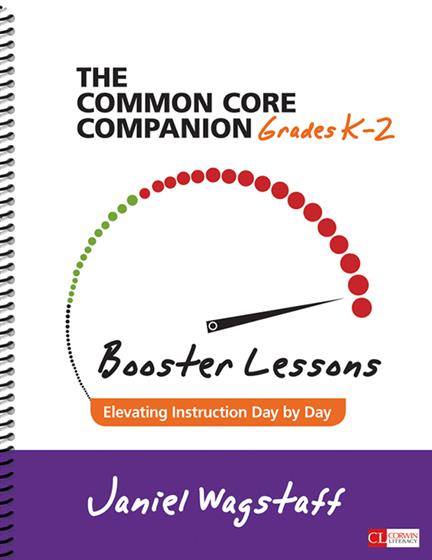Introduction
Lesson Sequence 1: Integrating Writing Personal Narratives With Identifying Sensory Words in Text
What Teachers Guide Across the Week
What Students Do Across the Week
Booster Reading Lesson 1: Narrative Reading
Companion Writing Lesson 1: Quick Sketch Retelling
Booster Reading Lesson 2: Narrative Reading, Brainstorm Topics, Tell Stories
Companion Writing Lesson 2: Story Planning
Booster Reading Lesson 3: Narrative Reading
Companion Writing Lesson 3: Review Story Plan, Add Onomatopoetic Element(s), Begin Drafting
Booster Reading Lesson 4: Compare Narrative Readings
Companion Writing Lesson 4: Continue Drafting, Connect Anchor Chart to Our Own Writing
Booster Reading Lesson 5: Poetry Reading
Companion Writing Lesson 5: Quick Write Noisy Poems, Finish Stories, Share, Celebrate
A Snapshot of the Talk-It-Out Strategy
Kindergarten Adaptation
Second-Grade Adaptation
NEXT INSTRUCTIONAL STEPS
What Do I See? A Student Sample of Story Planning
What Do I See? A Student Sample of Personal Narrative
Authentic Assessment: Ideas for Evaluating Students’ Learning
Peer Power: Using Student Work as Mentor Texts
If/Then Chart
Mentor Texts
Extending the Work
Lesson Sequence 2: Integrating Research to Build and Present Knowledge With Identifying Topic and Details
What Teachers Guide Across the Week
What Students Do Across the Week
Booster Reading Lesson 1: Viewing Media to Begin Information Gathering and Discussion
Companion Writing Lesson 1: Jot Topic and Details Using Interactive Writing
Booster Reading Lesson 2: Narrative Reading, Comparing Sources
Companion Writing Lesson 2: Informal Opinion Drawing and Writing
Booster Reading Lesson 3: Narrative Reading to Increase Background Knowledge
Companion Writing Lesson 3: Interviewing and Opinion Writing
Booster Reading Lesson 4: Reading and Discussing Our Fourth-Grade Partners’ Opinions
Companion Writing Lesson 4: Interactive Writing to Record Data
Booster Reading Lesson 5: Reading Mentor Texts for Parts of a Letter
Companion Writing Lesson 5: Interactive Writing to Inform About and Present Knowledge
A Snapshot of the Varied Writing Modes
First-Grade Adaptation
Second-Grade Adaptation
NEXT INSTRUCTIONAL STEPS
What Do I See? A Kindergarten Opinion Sample
What Do I See? Another Kindergarten Opinion Sample
Authentic Assessment: Ideas for Evaluating Students’ Learning
Peer Power: Using Student Work as Mentor Texts
If/Then Chart
Mentor Texts
Extending the Work
Lesson Sequence 3: Integrating Opinion Writing With Close Reading for Text Evidence
What Teachers Guide Across the Week
What Students Do Across the Week
Booster Writing Lesson 1: What Is an Opinion?
Companion Reading Lesson 1: Re-Identify Elements of the Text Type Using a Mentor Text
Booster Reading Lesson 2: Deeply Understanding a Text to Stimulate Opinion Writing
Companion Writing Lesson 2: Revisiting the Text to Quick Jot Opinion Notes, Followed by Collaborative Conversation
Booster Reading Lesson 3: Charting Character Development and Character Traits
Companion Writing Lesson 3: Organizing Our Opinions With Thinking Boxes
Booster Reading Lesson 4: Studying Mentor Texts: Concluding Opinions
Companion Writing Lesson 4: Completing Thinking Boxes and Drafting Opinions
Booster Reading Lesson 5: Exploring Multiple Forms and Purposes for Opinion Writing
Companion Writing Lesson 5: Completing and Reviewing Drafts, Sharing, Celebration and Delivering Opinions to the School Librarian OR Finish Writing and Celebrate!
A Snapshot of Moving From Opinions About Texts to Opinions About Topics
Kindergarten Adaptation
First-Grade Adaptation
NEXT INSTRUCTIONAL STEPS
What Do I See? A Student Sample of Opinion Writing
What Do I See? A Student Sample of Thinking Boxes
Authentic Assessment: Ideas for Evaluating Students’ Learning
Peer Power: Using Student Work as Mentor Texts
If/Then Chart
Mentor Texts
Extending the Work
Lesson Sequence 4: Integrating Comparing and Contrasting With Publishing Using Digital Tools
What Teachers Guide Across the Week
What Students Do Across the Week
Booster Reading Lesson 1: Reading Narrative Text
Companion Writing Lesson 1: Jot Sticky Note Details
Booster Reading Lesson 2: Reading Informational Text
Companion Writing Lesson 2: Jot Sticky Note Details Then Compare and Contrast
Booster Reading Lesson 3: View Short Video Clips to Build Knowledge
Companion Writing Lesson 3: Jot Sticky Note Details Then Compare and Contrast
Booster Reading Lesson 4: Which Ideas Are Most Important? Sort and Categorize
Companion Writing Lesson 4: Organizing Ideas With Thinking Boxes
Booster Writing Lesson 5: Compose Shared Text, Celebrate With Photo Story
Companion Reading Lesson 5: Mentor Text: Picture Glossaries
A Snapshot of Comparing and Contrasting With Narrative Text
Kindergarten Adaptation
Second-Grade Adaptation
NEXT INSTRUCTIONAL STEPS
What Do I See? A Sample of Shared Writing
What Do I See? A Student Sample of Thinking Boxes
Authentic Assessment: Ideas for Evaluating Students’ Learning
Peer Power: Using Student Work as Mentor Texts
If/Then Chart
Mentor Texts
Extending the Work
Lesson Sequence 5: Integrating Informative Writing With Use of Text Features
What Teachers Guide Across the Week
What Students Do Across the Week
Booster Reading Lesson 1: Reading With Purpose and an Eye for Evidence
Companion Writing Lesson 1: Two-Column Notes
Booster Reading Lesson 2: Close Reading of Media: Caine’s Arcade Video 1
Companion Writing Lesson 2: Revisit Media and Add to Two-Column Notes
Booster Reading Lesson 3: Close Reading of Media: Sections of Caine’s Arcade Video 2
Companion Writing Lesson 3: Two-Column Note Additions, Organizing Notes, Talking Out Caine’s Story
Booster Reading Lesson 4: Study Mentor Texts: Newsela Newspaper Articles
Companion Writing Lesson 4: Compose Headlines, Headings, and Begin to Draft
Booster Reading Lesson 5: Exploring Deeper Meanings: Caine’s Arcade Updates and Conversation
Companion Writing Lesson 5: Finish Draft, Peer Check, Teacher Conference, Publish! (will require several writing periods)
A Snapshot of Using Volunteers to Help Students Prepare to Publish
Kindergarten Adaptation
First-Grade Adaptation
NEXT INSTRUCTIONAL STEPS
What Do I See? A Student Sample of Informative Writing
What Do I See? A Student Sample of Two-Column Notes
Authentic Assessment: Ideas for Evaluating Students’ Learning
Peer Power: Using Student Work as Mentor Texts
If/Then Chart
Mentor Texts
Extending the Work
Integrating Foundational and Language Standards
References



